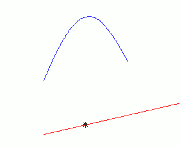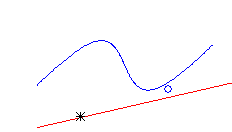![]()
Skipping PhysicsMay 2012 This month is a partial break from my series on Physics/Math/Music. I say "partial break" because I want to talk about sources of music such as vibrating strings. Being spring time I thought skipping would be a nice alternative way to introduce this part of the topic.
Ok, that Physicist perspective is probably pretty obscure, for now at least. I'll unravel it a bit over the next couple of months. This perspective on skipping actually first occured to me 20 years ago while teaching first year Physics at Acadia University. While discussing vibrations on a string I brought in a long rope, strung it across the front of the class and generated traveling waves, end reflections, and various harmonics of standing waves on a large scale so they could more clearly see the things drawn and explained in their textbook. It spontaneously occured to me that higher harmonics would make an interesting skipping rope and made a comment to that effect to the class. For example, here is my animation altered to show the second harmonic and the feet of a second jumper represented by a blue circle.
I get completely caught up in the rope when I try to skip so I cannot talk about this from any great personal experience. However, I have never seen kids playing and thought "alright, they're using higher than the first harmonic!" (yes, I am geek enough that I would think that way if I noticed it). So it seems to me that there is a whole extension to skipping that seems to be, "skipped", at least most of the time. One can go beyond the second harmonic, but the rope turner has increasing challenges for each increase in the number of the harmonic. To save a lot of space with diagrams and math, I'll refer the reader to the Wikipedia page on vibrations on a string. As of when I wrote this, the first screen of the Wikipedia page has a nice graphic of the first seven harmonics of a string. As is normal for introductory material this description is just a string vibrating up and down, not spinning around. Next month I'll talk about this. For now I'll just say that the same math applies to both, we just extend the concepts a bit for the rotation. So the first hamonic is a half wave with a node (fixed point) at each end. the second harmonic is a full wave with nodes the end and one in the middle. The third harmonic is one and a half waves with nodes at the ends and two in the middle, dividing the string evenly in three parts. And so on. One conceptual problem with applying these concepts to skipping is just sequence. We normally discuss vibrations from perspecitves such as a musical instrument where at the outset we have pulled a string (or wire) so tight that it is virtually straight, in spite of gravity. In contrast, a skipping rope hangs limp at the start. In fact, a non-vertical string supported only at the ends takes on a shape known as a Catenary. The difference between a skipping rope and a guitar string is simply that the guitar string is at a set tension and therefore has a defined set of harmonic frequencies, but you pick a frequency and harmonics by how you oscillate the skipping rope, and the appropriate tension results. The formulas that apply once the wave is in place are the same, it is just a matter of whether the tension determines the frequency or the frequency determines the tension. For simplicity I'm considering the rope to oscillate in a sinusoidal fashion. However, keep in mind:
Finally for this month, how about trying out higher harmonic skipping with a long rope and some friends this summer. If you have trouble getting it going in any but the first harmonic try this: pull the string reasonably tight and give a quick snap at one end. Watch the pulse go down the string and flip over when it reflects off the opposite end. Therefore, when it hits the opposite end start another pulse. They will meet and cancel in the middle. Keep sending pulses at this frequency and you should see a nice second harmonic shape developing. Transition to circles at the same frequency to get the rotating skipping rope going. If you want a bit more of a challenge maybe try varying the mass density of the string in sections to produce different lengths between the nodes. |

